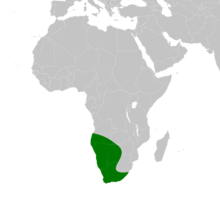Naja nigricincta
| Zebra spitting cobra Naja nigricincta | |
|---|---|
 | |
| N. n. nigricincta in Etosha National Park | |
| Scientific classification | |
| Kingdom: | Animalia |
| Phylum: | Chordata |
| Class: | Reptilia |
| Order: | Squamata |
| Suborder: | Serpentes |
| Family: | Elapidae |
| Genus: | Naja |
| Species: | N. nigricincta |
| Binomial name | |
| Naja nigricincta Bogert, 1940 | |
 | |
| The approximate range of Naja nigricincta in Africa | |
| Synonyms[1] | |
| |
Naja nigricincta is a species of spitting cobra in the genus Naja belonging to the family Elapidae.
This species had long been considered to be a subspecies of the black-necked spitting cobra (Naja nigricollis), but morphological and genetic differences have led to its recognition as a separate species.[2]
Subspecies
Two subspecies are currently recognized under Naja nigricincta.[1] The nominate subspecies N. n. nigricincta, commonly known as the zebra spitting cobra or western barred spitting cobra, is given its name because of the dark crossbars that run the length of the snake's body. The subspecies N. n. woodi, commonly known as the black spitting cobra, is solid black and is found only in the desert areas of southern Africa.[3] Both subspecies are smaller than N. nigricollis; with average adult lengths of less than 1.5 metres (4.9 ft).[4][5]
| Subspecies | Taxon author | Common name | Geographic range | Regional Differences |
|---|---|---|---|---|
| N. n. nigricincta | Bogert 1940[6] | Zebra spitting cobra, Western barred spitting cobra, Zebra Snake | Central and northern Namibia and southern Angola | Grey brown, yellow, or pink with dark bands from head to tail |
| N. n. woodi | Pringle 1955[7] | Black spitting cobra | Central and western Namibia, South Africa (Cape Province) | Solid black, or grey body with black hood and head, in some cases it is outwardly identical to Naja nigricollis and can only be distinguished by size and range. |
Description
Naja nigricincta is an oviparous venomous spitting cobra with dark brown to black body and zebra-like vertical whitish or light yellow stripes along the dorsal side. These stripes are generally evenly spaced and can be complete or fragmented. The ventral scales range from white to orange in color. In juvenile snakes the overall coloration is lighter than in the adults,
These snakes can flatten head and neck into a hood, similarly to many species of cobra. The heads and hoods are uniformly dark brown or black.
The venom of Naja nigricincta can cause massive hemorrhaging, necrosis and paralysis in bite victims. These snakes can also spit its venom, hitting their enemies with great accuracy and causing temporary or permanent blindness.[8]
Distribution
This species is native to parts of southern Africa (Namibia, southern Angola and South Africa).
References
- 1 2 "Naja nigricincta BOGERT, 1940". Reptile Database. http://reptile-database.reptarium.cz. Retrieved 14 February 2012. External link in
|publisher=(help) - ↑ Wuster, Wolfgang. "The phylogeny of cobras inferred from mitochondrial DNA sequences: Evolution of venom spitting and the phylogeography of the African spitting cobras (Serpentes: Elapidae: Naja nigricollis complex)" (PDF). Bangor University. Retrieved 14 February 2012.
- ↑ Haslinger, Arnold (2015) Black spitting cobra in Europe www.herpetofauna.co.uk
- ↑ Mastenbroek, Richard. "Black-neck Spitting Cobra" (PDF). DEVENOMIZED. www.devenomized.com. Retrieved 20 December 2011.
- ↑ "Kraits Cobras Sea Snakes and Relatives: Elapidae - Black-necked Spitting Cobra (naja Nigricollis): Species Accounts". Retrieved 21 December 2011.
- ↑ Bogert, CM (1940). "Herptologie d' Angola et du Congo". Lisbon: Impromerie Nationale.
- ↑ Pringle, J (1955). "A new subspecies of the spitting cobra Naja nigricollis from the Cape Province". 13 (2). Natal Museum: 253–254.
- ↑ Jake Boy The Harvard University Herpetology Course - OEB 167 - Encyclopedia of life